Previous FI Curriculum – Ch. 4
Definite articles with physical characteristics
The definite article (le, la, l’, les) is often used with parts of the body instead of a possessive determiner (mon, ma, mes, etc.). Sentences with this structure always use the verb avoir to indicate that the possessor is the subject of the sentence. The following French sentences are equivalent.
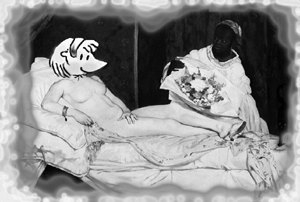
| Tex rêve: Ah, Tammy! Tu as les yeux brûlants, la bouche pulpeuse, les cheveux si doux … | Tex is dreaming: Ah Tammy! You have fiery eyes, full lips, such soft hair … | |
| Tex rêve: Ah Tammy! Ton regard est brûlant, ta bouche pulpeuse, tes cheveux si doux … | Tex is dreaming: Ah Tammy! Your eyes are fiery, your lips full, your hair so soft … |
However, an indefinite article is used if an adjective comes before the part of the body:
| Tex continue: Tammy, tu as un petit nez pointu et de grandes oreilles décollées … | Tex continues: Tammy, you have a little pointed nose and big ears which stick out … |
The definite article is also always used when pronominal verbs refer to parts of the body.
Adjectives that precede the noun
The placement of most adjectives in French is after the noun: un escargot parlant, une fourmi travailleuse, des tatous intelligents, etc. There is a small group of adjectives, however, that normally precede the noun. These adjectives may be categorized as adjectives of Beauty, Age, Numbers, Goodness, and Size (BANGS).
| autre | other |
| beau (belle) | beautiful |
| bon (bonne) | good |
| grand (grande) | tall, big |
| gros (grosse) | big, fat |
| jeune | young |
| joli (jolie) | pretty |
| mauvais (mauvaise) | bad |
| nouveau (nouvelle) | new |
| petit (petite) | little |
| vieux (vieille) | old |
ordinal numbers:
| premier | (première), first |
| deuxième | second |
| troisième | third, etc. |
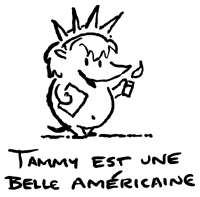
| Tammy est une belle Américaine. C’est aussi une bonne amie. C’est une petite tatou. | Tammy is a beautiful American woman. She is also a good friend. Tammy is a little armadillo. | |
| Trey est le jeune frère de Tex. C’est le troisième enfant de la famille. | Trey is Tex’s young brother. He is the third child in the family. |
beau, nouveau, vieux
Beau, nouveau, and vieux have irregular forms. Note the special forms in the masculine singular when they precede a word that begins with a vowel or a silent h.
| masculine singular |
masculine before vowel |
feminine singular |
masculine plural |
feminine plural |
| beau | bel | belle | beaux | belles |
| nouveau | nouvel | nouvelle | nouveaux | nouvelles |
| vieux | vieil | vieille | vieux | vieilles |
The adjectives which precede the noun must agree in number and gender with the noun they modify (see the regular rule for adjective formation). Be aware that changing the position of some adjectives may change their meaning. Listen to this dialogue:
| Tex et Tammy regardent le nouvel album de famille de Rita. | Tex and Tammy are looking at Rita’s new family album. | |
| Tammy: Qui est cette belle femme? | Tammy: Who is that beautiful woman? | |
| Rita: C’est notre mère. | Rita: That’s our mother. | |
| Tammy: Et qui sont ces autres personnes? | Tammy: And who are these other people? | |
| Rita: Le vieil homme, c’est Paw-Paw Louis. Et puis, à côté, c’est moi. | Rita: The old man, that’s Paw-Paw Louis. And then, next to him, that’s me. | |
| Tex: Et ce petit bébé, qui est-ce? Comme il est laid! | Tex: And the little baby, who is it? Boy is he ugly! | |
| Rita: C’est toi, Tex. C’est la première photo de toi. | Rita: That’s you, Tex. It’s the first picture of you. |
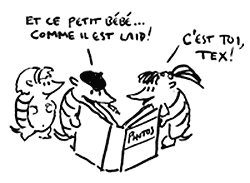 Irregular adjectives
Irregular adjectives
Regular adjectives are formed by adding an e to the masculine form in the singular (content / contente), or by adding an s to the masculine and feminine forms in the plural (Tex et Edouard sont contents / Tammy et Bette sont contentes). This group of adjectives is by far the most common. There are, however, a number of adjectives which are called irregular, because they do not have the normal –e, –s, or –es endings. The endings of these irregular adjectives vary widely and often change the pronunciation.
Gender
Some adjectives are completely irregular:
| masculine | feminine | translation |
| doux | douce | soft |
| faux | fausse | false |
| favori | favorite | favorite |
| frais | fraîche | fresh |
| long | longue | long |
| public | publique | public |
Other adjectives can be grouped in categories:
| masculine ending | feminine ending | french | english |
| -el | -elle | cruel / cruelle | cruel |
| -eil | -eille | pareil / pareille | similar |
| -il | -ille | gentil / gentille | kind, nice |
| -on | -onne | mignon / mignonne | cute |
| -s | -sse | gros / grosse | big, fat |
| -en | -enne | ancien / ancienne | old |
| -et | -ète | secret / secrète | secretive |
| -er | -ère | cher / chère | dear, expensive |
| -eux | -euse | heureux / heureuse | happy |
| -eur | -euse | trompeur / trompeuse | deceptive |
| -teur | -trice | créateur / créatrice | creative |
| -f | -ve | actif / active | active |
| -c | -che | franc / franche | frank |
| -ou | -olle | fou / folle | crazy |
Some adjectives have identical masculine and feminine forms. This is generally the case with adjectives ending in e in their masculine form and with foreign adjectives like ‘snob’, ‘cool’, etc. For example: Tex est un tatou imaginaire; Tammy aussi est imaginaire. Ils sont imaginaires. (Tex is an imaginary armadillo; Tammy too is imaginary. They are imaginary.) Here are a few of these adjectives:
| pauvre | poor |
| difficile | difficult |
| sensible | sensitive |
| riche | rich |
| calme | calm |
| semblable | similar |
| mince | slim |
| minuscule | tiny |
| ridicule | ridiculous |
| propre | clean |
| ironique | ironic |
| imaginaire | imaginary |
Number
The majority of adjectives are regular in the plural; that is, an -s is added to the singular masculine or feminine forms. There are two major exceptions to this rule:
- Do not add an s to the masculine form of adjectives ending in s or x. The masculine singular and plural forms are thus identical: un animal heureux (a happy animal), des animaux heureux (happy animals). However, the feminine plural form of these adjectives is regular; it is formed by simply adding an s to the feminine singular form: une fille heureuse (a happy girl), des filles heureuses (happy girls).
- Adjectives ending in al in the masculine singular form change to aux in the masculine plural form.
| Tex est un tatou international. Edouard et Tex sont des animaux internationaux. | Tex is an international armadillo. Edouard and Tex are international animals. |
The feminine plural form of these adjectives is regular; it is formed by simply adding an s to the feminine singular form: Tex aime lire la presse internationale. Tex aime aussi les revues internationales. (Tex likes to read international papers. Tex also likes international magazines).
Listen to this dialogue:
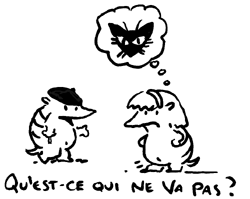
| Tex: Mais, qu’est-ce qui ne va pas? | Tex: But, what’s wrong? | |
| Tammy: C’est encore Bette! Elle n’est jamais sincère! Sois franc Tex. Tu ne la trouves pas capricieuse et cruelle? | Tammy: It’s Bette again! She is never sincere! Be frank Tex. Don’t you find her capricious and cruel? | |
| Tex: Non! Elle est gentille! C’est une bonne amie! Qu’est-ce qu’elle a fait? | Tex: No! She is nice! She is a good friend! What did she do? | |
| Tammy: Comme tu es naïf! Elle me raconte que tu me trouves ennuyeuse, que tu es amoureux d’une de tes étudiantes. C’est vrai? | Tammy: You are so naive! She tells me that you think I’m boring, that you are in love with one of your students. Is that true? | |
| Tex: Tu es folle! C’est une fausse accusation! | Tex: You’re crazy! It’s a false accusation! | |
| Tammy: Hmm … Tu veux que je t’explique? C’est très clair. Elle est jalouse! C’est le complot classique. Elle essaie de nous séparer, nous des amis si loyaux! | Tammy: Hmm … Do you want me to explain? It’s very clear. She is jealous! It’s the classic plot. She is trying to separate us, such loyal friends! |
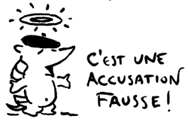 Comparisons with adjectives
Comparisons with adjectives
Comparative adjectives indicating more or less
Adjectives are frequently used to compare things, people, events, ideas etc. Plus … que conveys the idea of ‘more … than’, moins … que the idea of ‘less than.’
| Tex est plus intelligent que Joe-Bob. | Tex is more intelligent than Joe-Bob. | |
| Mais Joe-Bob est moins prétentieux que Tex. | But Joe-Bob is less pretentious than Tex. | |
| Bien sûr, il est plus difficile d’être poète que d’être écureuil! | Of course, it is more difficult to be a poet than to be a squirrel. |
Comparative adjectives indicating similarity or equality
Aussi … que conveys the idea of ‘as … as’.
| Fiona est aussi belle que Tammy. Mais elles ne sont pas aussi séduisantes que Bette. | Fiona is as beautiful as Tammy. But they are not as seductive as Bette. |

Irregular adjectives
The adjectives bon and mauvais have irregular forms of comparison, meilleur and pire. However, the regular form plus mauvais que has become commonly accepted. Note that this irregularity is found in English too with ‘better’ (not *gooder) and ‘worse’ (not *badder).
| D’après Tex, Tammy est un bon parti. Mais Bette pense qu’elle serait un meilleur parti que Tammy. | According to Tex, Tammy is a good match. But Bette thinks she would be a better match than Tammy. | |
| Mais il est évident que le caractère de Bette est plus mauvais que celui de Tammy. | But it is obvious that Bette’s personality is worse than Tammy’s. |
Listen to this dialogue:
| Bette: Tex, as-tu jamais vu une fille aussi jolie que moi? | Bette: Tex, have you ever seen a girl as pretty as I am? | |
| Tex philosophe: Euh! La beauté physique est moins importante que la beauté de l’âme. Voyons Bette, je n’ai pas le temps de penser à des choses aussi triviales que celles-ci … | Tex the philosopher: Ah! Physical beauty is less important than the beauty of the soul. Look Bette, I do not have time to think about things as trivial as that … | |
| Bette: D’accord, d’accord, mais je suis moins bête et plus sexy que Tammy, non? | Bette: Ok, ok, but I am less stupid and more sexy than Tammy, don’t you think? | |
| Tex: Être ou ne pas être, là est la question … | Tex: To be or not to be, that is the question … |
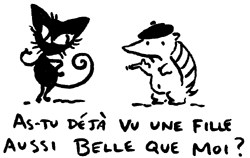 Pronominal verbs
Pronominal verbs
A pronominal verb is a verb that is accompanied by a reflexive pronoun. Pronominal verbs fall into three major classes based on their meaning: reflexive, idiomatic, and reciprocal. You have probably already seen the pronominal verb s’appeler (Comment t’appelles-tu? What is your name?). To conjugate pronominal verbs in the present tense, you need to pay attention to both the pronoun and the verb form. Listen carefully to the conjugation of the following pronominal verb. The verb is conjugated normally (here an -er verb) with addition of the reflexive pronouns me, te, se, nous, vous, se.
| se raser ‘to shave oneself’ | |
| je me rase | nous nous rasons |
| tu te rases | vous vous rasez |
| il/elle/on se rase | ils/elles se rasent |
reflexive verbs
Pronominal verbs often express reflexive actions, that is, the subject performs the action on itself. If the subject performs the action on someone else, the verb is not reflexive. Here is a list of common reflexive verbs:
| s’asseoir | to sit (down) |
| s’appeler | to be called |
| s’arrêter | to stop |
| se brosser | to brush |
| se coucher | to go to bed |
| s’habiller | to get dressed |
| se laver | to wash |
| se lever | to get up |
| se promener | to take a walk |
| se réveiller | to wake up |
Compare the difference in meaning between se raser and raser in the following sentences. Note that English does not usually indicate reflexive meaning explicitly since it can be inferred from the context. However, if reflexive meaning is intended in French, then it must be explicitly stated by using a reflexive pronoun.
| Est-ce que Tex se rase? Mais non, Tex, c’est un tatou. Il n’a pas de cheveux. | Does Tex shave? Why no, Tex is an armadillo. He has no hair. | |
| Qu’est-ce qu’il fait, Tex, avec le rasoir? Il rase Joe-Bob pour l’été. | What’s Tex doing with the razor? He’s shaving Joe-Bob for the summer. |
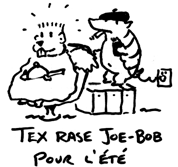
To negate pronominal verbs, place the ne before the reflexive pronoun and the pas after the verb. When used with an auxiliary verb such as aimer (to like), the infinitive of a pronominal verb agrees with its subject. When pronominal verbs are used with parts of the body, they take the definite article (le, la, les) rather than the possessive article as in English: Tex se lave les mains. (Tex washes his hands.)
| Joe Bob: Edouard, est-ce que tu te rases? | Joe Bob: Edouard, do you shave? | |
| Edouard: Non, je ne me rase pas. | Edouard: No, I don’t shave. | |
| Les escargots ne se rasent pas. Pourtant, nous nous lavons le visage tous les jours. | Snails don’t shave. However we do wash our faces every day. | |
| Joe-Bob: Ah, tu as de la chance. Je déteste me raser. |
idiomatic verbs
Some pronominal verbs are idiomatic and do not represent reflexive actions per se. s’amuser (to have fun) and se reposer (to rest) are examples of pronominal verbs with idiomatic meanings. The following list includes common idiomatic pronominal verbs:
| s’amuser | to have fun |
| se dépêcher | to hurry |
| s’endormir | to fall asleep |
| s’ennuyer | to be bored |
| s’entendre | to get along |
| se fâcher | to get angry |
| se marier | to get married |
| se passer | to happen |
| se reposer | to rest |
| se sentir | to feel |
| se souvenir de | to remember |
| se taire | to be silent |
| se tromper | to make a mistake |
| se trouver | to be (situated) |
reciprocal verbs
A third category of pronominal verbs expresses a reciprocal action between more than one person, s’aimer or se parler, for example. The English equivalent often uses the phrase ‘each other’ to represent this reciprocal action. Here is a list of common reciprocal verbs:
| s’aimer | to love each other |
| se détester | to hate each other |
| se disputer | to argue |
| s’embrasser | to kiss |
| se parler | to talk to each other |
| se quitter | to leave each other |
| se regarder | to look at each other |
| se retrouver | to meet each other |
| se téléphoner | to telephone each other |
To form the imperative of pronominal verbs, drop the subject pronoun and then attach the reflexive pronoun with a hyphen to the right side of the verb. The reflexive pronoun te becomes toi when used in the imperative. Dépêche-toi! Hurry up!, Souvenons-nous. Let’s remember., Amusez-vous! Have fun!
| Tammy décrit ses rapports avec Tex. | Tammy describes her relationship with Tex. | |
| Tammy: Nous nous entendons très bien, sauf quand il se fâche. | Tammy: Usually we get along very well except when he gets angry. | |
| Il me dit, «Assieds-toi et tais-toi, ma petite.» | He tells me “Sit down and shut up, little one!” | |
| Mais nous nous aimons même si nous nous disputons un peu. | But we love each other even if we fight a little bit. | |
| Nous allons nous marier un jour. | We’re going to get married someday. |
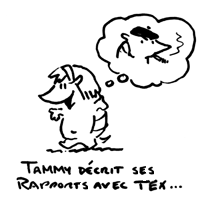 c’est vs. il/elle est
c’est vs. il/elle est
To describe and introduce things or people in French, two common phrases are used: c’est and il/elle est. The plural forms are ce sont and ils/elles sont.
The choice between c’est and il / elle est is not always easy, but there are basic principles which can guide you in the choice. A rule of thumb is that c’est or ce sont are followed by a determined noun (‘le tatou’, ‘une Américaine’, ‘mes livres’). Remember that nouns in French are preceded by a determiner. Il/elle est and ils/elles sont are followed by an adjective (‘content’, ‘sympathique’).
c’est/ce sont
C’est and ce sont are followed by the following:
| + noun, including modified nouns | Tex? C’est un tatou. C’est un Américain. C’est un petit tatou bilingue.
Tammy et Tex? Non, ce ne sont pas des chats! Ce sont des tatous. |
Tex? He’s an armadillo. He is an American. He is a small bilingual armadillo.
Tammy and Tex? No they are not cats! They are armadillos. |
| + proper noun | C’est Tex. | It’s Tex. |
| + disjunctive pronoun | Tammy: Allô Tex? C’est moi.
Tex: Qui est-ce? Ah, c’est toi Tammy! |
Tammy: Hello Tex? It’s me.
Tex: Who is this? Oh, it’s you Tammy! |
| + dates | Tex: Mon anniversaire? C’est le quatorze juillet. C’est jeudi prochain! | Tex: My birthday? It’s July 14th. It’s next Thursday! |
| + an infinitive as subject | Tex: Vivre, c’est parler français. | Tex: To live is to speak French! |
| + adjective for non-specific referents | Tex: Ah c’est chouette! C’est incroyable! | Tex: Oh, that’s neat! That’s unbelievable. |

il/elle est/ils/elles sont
Use il/elle est or ils/elles sont to introduce the following:
| + adjective alone | Tex? Il est arrogant! Il n’est pas français. Il est américain.
Tammy? Elle est gentille. |
Tex? He is arrogant! He isn’t French. He is American.
Tammy? She is nice. |
| + nationality, occupation, religion (used as adjectives in French) | Tex? Il est poète.
Trey? Il est musicien. Tammy? Elle est étudiante |
Tex? He is a poet.
Trey? He is a musician. Tammy? She is a student. |
Remember that il(s) and elle(s) refer to a specific person or thing. Ce does not refer to a specific person or thing; it is usually translated as that.
| Il est stupide. (He‘s stupid.) | C’est stupide. (That‘s stupid.) |

